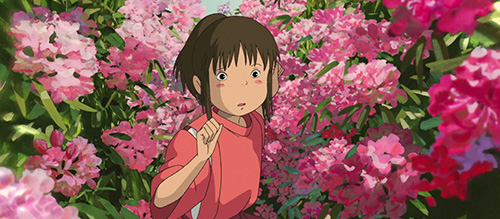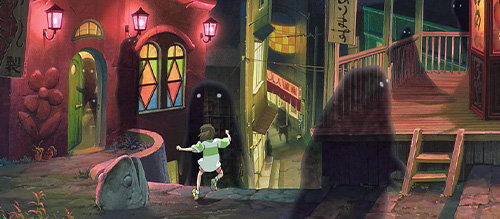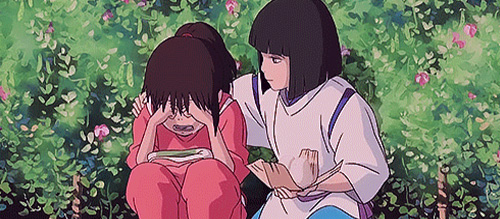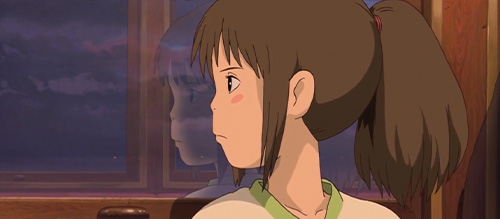‘Spirited Away’ at 20 – Review
Spirited Away (2001)
Director: Hayao Miyazaki
Screenwriter: Hayao Miyazaki
Starring (English Dub): Daveigh Chase, Suzanne Pleshette, Jason Marsden, Susan Egan, David Ogden Stiers
It may be pretentious to claim that 20 years of Hayao Miyazaki’s Spirited Away is an occasion of solemnity, but it is undeniable that for many people the marking of this particular passage of time brings the realisation of enormous change in our media and within ourselves. Regarded as one of the very best animated films ever made, Spirited Away broke records, being the first film ever to earn a gross of $200 million before opening in the US, which would come naturally with it being the highest grossing Japanese film of all time until 2020’s Demon Slayer The Movie: Mugen Train. Beyond the subject of money and awards (Best Animated Feature Oscar 2003 among many), Spirited Away’s most significant impact is how it broadened the horizons for those who encountered it. This was many people’s first introduction to international cinema, let alone that of Japanese cinema, and for some they have never looked back. In the 20 years since its initial release, more and more of the self-confessed film buff community have rejected Hollywood in favour of the broader scope of World Cinema, particularly that of Asia; a point emphasised by the critical and commercial success of 2020 Oscars Best Picture winner Parasite (South Korea). There’s no doubt that Spirited Away is a Miyazaki masterpiece that belongs among the greats of the world’s stage, and 20 years on the reasons seem to only grow clearer by the day.
Spirited Away is the story of a typical 10 year old girl, Chihiro (Daveigh Chase), who we find sulking in the back seat of her parents’ car, feeling dour over the family decision to move house. En route to their new home, the family stumble across a mysterious tunnel in the middle of the forest, leading to what appears to be an abandoned theme park. Despite Chihiro’s protests, her parents continue to explore and begin feverishly devouring sumptuous looking unattended food. It is Chihiro who discovers that the mysterious place is actually a bathhouse, but when she returns to her parents she discovers to her horror that they have turned into pigs. Chihiro’s family seems to have unfortunately wandered into the spiritual realm, specifically where the Gods and spirits go to relax and replenish themselves. Consequentially, Chihiro’s parents’ transformation into pigs is their punishment for gorging on the food of the spirits; Chihiro’s only hope is to get a job in the bathhouse, ran by a cruel witch, Yubaba (Suzanne Pleshette). As a human in the spirit world, Chihiro’s life (whose name is now Sen) is fraught with hardship, but with the help of some unexpected allies, she is able to prove herself and win back the freedom of both her parents and herself. Moreso, by the power of her human nature she is able to save some of the tormented beings trapped in Yubaba’s bathhouse through her love and kindness.
In its 30 year history, the films of the Studio Ghibli catalogue can all be categorised by their incredible originality and stunning animation. Hayao Miyazaki’s mission of breathing a new wind into Anime with the founding of Studio Ghibli is vindicated by the universal hailing of him as “The Auteur of Anime” and Spirited Away is no exception to his work ethic, fit to burst with his directorial trademarks and craftsmanship.
Whole essays can be (and have been) written on the sublime animation in Miyazaki’s work, and consistent with his previous works Spirited Away proves to be just as beautiful and inventive. Not one element of animation is neglected with exterior backgrounds comparable to the works of Turner and Monet, and interiors filled with a dizzying amount of intricacy. The characters themselves betray the huge amount of creativity poured into Miyazaki’s storytelling with inspiration taken from his surrounding culture and nature. Adult or child, your eyes can’t help but to gorge upon the visual feast served up in every frame.
Amongst the myriad of animations released in the last 20 years that have made the most of the ever-developing technologies in CGI (particularly those innovated in the films of Walt Disney and Pixar animation studios) it is Spirited Away, rooted in its traditional techniques (with only the subtle use of 3D animation) that is still widely regarded as the best animated film ever made. This is because the power of Spirited Away’s animation is not just based on aesthetics but in how integrated it is in the storytelling process: Miyazaki’s films are rarely scripted, with the story coming about nearly entirely by the storyboard process.
Therefore, the resulting animation is visceral and fraught with the kind of raw emotion that resounds with children and transports adults to their formative years. The use of food by Miyazaki (as part of his trademark flourish) translates the most relatable sensations of indulgence and gluttony into an aching familiarity. He even successfully illustrates the dual nature of food representing both its precious sustenance and its corrupting power. This animation style leads to a vivid depiction of the human experience as it combines realism gained by the careful study of life with moments of exaggeration: Sen’s hair standing on end as she encounters the stink of a stench spirit and the distinctive squish of an authentic Studio Ghibli hug. These exaggerations never go too far as to ruin the tone of a moment, just to accentuate it, and most comical turns are left to the more fantastical characters so as not to ruin the illusion of the piece.
The intense realism and immersion of Spirited Away can also be credited to Miyazaki’s iconic use of the concept “Ma”, which are the moments of stillness (or emptiness in Miyazaki’s own words) found in all of his works. According to an interview he had with Roger Ebert:
“If you just have non-stop action with no breathing space at all, it’s just busyness, But if you take a moment, then the tension building in the film can grow into a wider dimension. If you just have constant tension at 80 degrees all the time you just get numb.”
The quiet moment in which Chihiro meets with the mysterious Haku (Jason Marsden) to see her parents and then cries whilst eating rice balls is a segment with no action or new exposition, but lets us look at this newly discovered spirit world through Chihiro’s eyes. We see what she sees as we are all strangers in this place, and as such feel as she feels. Has there been a greater moment of movie magic than the painful lump we feel in our throats as we share in Chihiro’s tears of fatigue, fear and sorrow?
Continuing with Studio Ghibli’s principle of authenticity, Spirited Away‘s continuing acclaim can be attributed to its refusal to compromise. Most western audiences’ first experience with this feature was through the English dub, recorded in collaboration with Walt Disney Animation, under the watchful eye of John Lasseter of Pixar fame. Spirited Away could very well have been in danger of being chopped and butchered in favour of creating something more palatable to western audiences. Instead, both Studio Ghibli and Miyazaki insisted on there being no cuts to any of their films in any Disney re-issue. As such, the story of Spirited Away remains intact, the only difference between the Japanese and the English versions being the addition of dialogue to reiterate important plot points that could be lost on Western audiences, such as the theme park being a bath house.
Introducing the fullness of Miyazaki’s vision to the West means that the film is elevated beyond high quality entertainment and art into what is effectively an open door. As Spirited Away is the tale which deals with both the human and ethereal realm, it takes influence from not only Japanese culture but its philosophies and belief systems. The actual plot of Spirited Away is heavily influenced on the Shinto Myth of Izanagi and Izanami and it is through these intrinsic influences that this film invites audiences to accept these elements of Shintoism at face value, a religion that a significant proportion of Western audiences would be largely unfamiliar with. Free from heavy handed explanation of these spiritual intricacies, Spirited Away silently but effectively shatters the echo chamber of western philosophy. For children in particular, the door is opened beyond the horizons of their surrounding culture, which is the testament of any good film.
What still remains to be the most outstanding feature of Spirited Away, however, is the story itself. On the surface it doesn’t seem particularly innovative compared to other animated greats or from the rest of Ghibli’s filmography – a young female protagonist in a fantasy setting – but there is a certain distinctiveness when it comes to Chihiro; Miyazaki has stated that the inspiration for this film came from meeting the grumpy ten year old daughter of a close friend, which can clearly be seen in Chihiro, and she is the first young female protagonist to be actually voiced by a child in both the English and Japanese versions. The most important detail is that Spirited Away was made with the young female demographic in mind. Through Miyazaki’s observational approach, Spirited Away is one of the greatest realisations of the anxieties and fears of ten year old girls. And it’s not just about the obvious stuff of losing her parents; its the frustrating injustices as the adults in your life forget to value your opinion, not being good enough to these same adults, and being seen as inadequate before you have had time to prove yourself.
In the past 20 years, the conversation of what makes a strong female character has arisen time and time again and often enough the answer given usually resembles someone in a catsuit toting a gun. It is truly upsetting that this image of hyper-sexualisation and the assimilation of masculinity is readily accepted as the answer, so the antithesis served up by Spirited Away is practically an act of redemption. Chihiro is a character without super or magical powers, and even in terms of being an ordinary human she is not particularly remarkable and holds no special talent. It is her humanity that makes her the undeniable heroine. It is her curiosity that transforms the formidable stench spirit into its true form when all of her superiors simply want to take its money; it is her pity that makes it so that No Face experiences hospitality and friendship; and of course it is her faith and love that saves Haku’s life.
Most importantly, Chihiro is the ultimate representation of female empowerment: despite being in a story in which she is effectively spirited away, she exercises her own agency. She does get helped along the way, but it is her determination to help herself and her parents that propels the plot forward, facing her fears to demand a job from Yubaba and confront Zeneba over the fate of Haku. In the end it is Chihiro that saves herself and her parents.
In an industry that constantly ignores young female audiences, it is a blessing to have a well-written character just like them in a film just for them. In the continued struggle of sexual equality, it is needed now more than ever to share the truth that a woman doesn’t have to sacrifice her femininity to be strong. Hayao Miyazaki has always used his art to convey the messages he feels are urgent enough to share with the world, and with Spirited Away’s continued popularity Miyazaki’s quiet tale of a young girl’s agency is still very much needed and has not yet been beaten by the animation giants of the West.
24/24
Recommended for you: 10 Best Studio Ghibli Films






Beautiful film and beautifully written article!